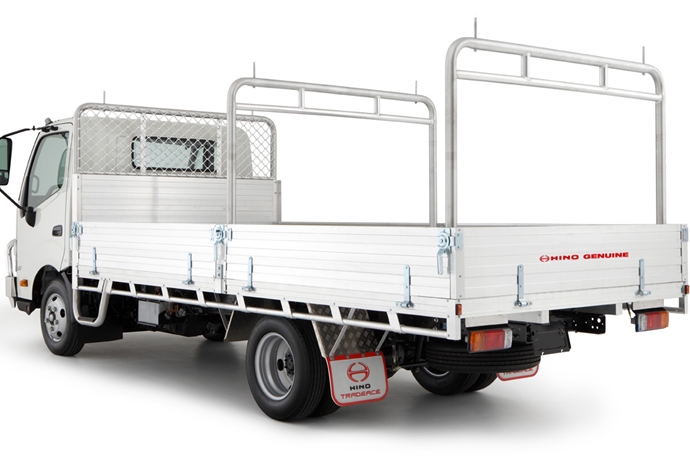
So you’re looking to buy or upgrade a truck for your business and you’ve research on the right engine, the comfort… but what about the right tray? We recently talked to Dave Dickman, Managing Director at Transalloy about what to consider when customising your tray for your truck.
If someone buys a Hino, how do they get a tray that suits their business?
Before speaking to your local Hino dealer, there are a few questions to ask yourself:
1. What industry are you in? i.e plumber, builder etc.
2. What materials will be regularly loaded into the tray of your Hino? i.e Concrete, jackhammers, sand, pipes etc.
3. Do you need any additional equipment to be mounted on the back? We have previously put cranes on the back of a Hino, which have specific load, weight and thickness requirements.
There are also legal requirements (according to state regulations) for restraining the load in your truck that need to be adhered to. Something your dealer can help you with.
Consideration needs to be given to the material you will be loading in your tray. An example I like to use is a tonne of feathers and a tonne of rocks, each weighs a tonne, but each item will impact the vehicles stability and weight bearing when you go around corners or speed bumps.
Another big consideration to think about is the concentration of your load - weight bearing is essential. I had a customer come to us who moved concrete bollards, the weight of his load was always concentrated to the centre of the tray and eventually his tray bent under the pressure. The tray was suitable for the weight he wanted, but it was never spread evenly.
There are different types of materials to use, what would you recommend?
There are a number of different types of materials but the main two are Aluminium and Steel. I also see plastic starting to become apparent in the industry, but it's not where the metals are just yet.
Aluminium
We prefer to use aluminium, as the benefits mean it can be easily adapted and modified to suit the customer’s needs.
Aluminium has a quick build turnaround time, it’s much more manageable to mould and suit to each truck and has more options for more industries. For instance, we can drill small holes into the floor and it won’t interrupt the integrity and performance of the floor due to its unique engineering design.
Steel
The steel tray is more durable and ideal for those trades that need something stronger and won’t be as worried about the potential of piercing a hole through the tray. Trades such as concreters, builders etc tend to prefer a steel tray as it tends to maintain its longevity in comparison to an aluminium.
A major benefit of a steel tray is that it’s not susceptible to point loads, so the weight doesn’t have to be divided evenly on the tray, meaning the tray will have a minimal risk of bending. Don’t forget that any loading of trays has strict state regulations.
The downside to steel is that is literally almost weighs a tonne! It adds a lot of weight to your truck, reducing the amount of payload you can carry every day.
An aluminium tray weighing in at 310kgs with racks is almost 1/3 the weight of the same dimensioned steel tray taking almost 575kgs off your payload.
Overall costs
Steel and aluminium actually can come in at a similar cost (material wise), but steel has a much longer lead time to manufacture and also get right. Steel can take a few weeks to produce whereas aluminium can be turned around in a day.
Don’t forget that unless you use pre-galvanised metal, you’ll scratch the paint and basically, it’s going to rust. This adds additional costs to your tray specs.
For more information on getting the right product to suit your business needs, talk to your local Hino dealer.